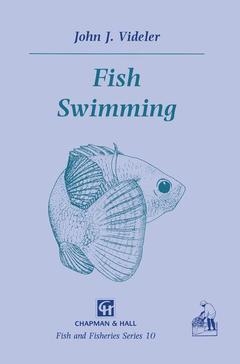Description
Fish Swimming, 1993
Author: Videler J.J.
Language: English
Subjects for Fish Swimming:
Keywords
Fish Swimming
Publication date: 11-2012
260 p. · 15.5x23.5 cm · Paperback
Publication date: 11-2012
260 p. · 15.5x23.5 cm · Paperback
Fish swimming (printed on demand)
Publication date: 07-1993
260 p. · 15.5x23.5 cm · Hardback
Publication date: 07-1993
260 p. · 15.5x23.5 cm · Hardback
Description
/li>Contents
/li>Comment
/li>
Among the fishes, a remarkably wide range of biological adaptations to diverse habitats has evolved. As well as living in the conventional habitats of lakes, ponds, rivers, rock pools and the open sea, fish have solved the problems of life in deserts, in the deep sea, in the cold antarctic, and in warm waters of high alkalinity or of low oxygen. Along with these adaptations, we find the most impressive specializations of morphology, physiology and behaviour. For example we can marvel at the high-speed swimming of the marlins, sailfish and warm-blooded tunas, air-breathing in catfish and lung fish, parental care in the mouth-brooding cichlids and viviparity in many sharks and toothcarps. Moreover, fish are of considerable importance to the survival of the human species in the form of nutritious, delicious and diverse food. Rational exploitation and management of our global stocks of fishes must rely upon a detailed and precise insight of their biology. The Chapman & Hall Fish and Fisheries Series aims to present timely volumes reviewing important aspects of fish biology. Most volumes will be of interest to research workers in biology, zoology, ecology and physiology but an additional aim is for the books to be accessible to a wide spectrum of non-specialist readers ranging from undergraduates and postgraduates to those with an intrerest in industrial and commercial aspects of fish and fisheries.
1 Interactions between fish and water.- 1.1 Introduction.- 1.2 Properties of water.- 1.3 Buoyancy, weight, thrust and drag.- 1.4 The footprints of a fish.- 1.5 Transmission of forces between fish and water.- 1.6 Summary and conclusions.- 2 The structure of the swimming apparatus: muscles.- 2.1 Introduction.- 2.2 Lateral muscles and septa.- 2.3 Different muscle fibres.- 2.4 Innervation.- 2.5 Summary and conclusions.- 3 The structure of the swimming apparatus: body axis and fins.- 3.1 Introduction.- 3.2 The median septum and vertebral column.- 3.3 Fin rays.- 3.4 Fins.- 3.5 Summary and conclusions.- 4 The structure of the swimming apparatus: shape, skin and special adaptations.- 4.1 Introduction.- 4.2 Streamlined bodies.- 4.3 The structure of fish skin.- 4.4 Special adaptations.- 4.5 Summary and conclusions.- 5 Fish kinematics: history and methods.- 5.1 Introduction.- 5.2 Historical overview.- 5.3 Methods for kinematic studies on fish.- 5.4 Examples of the analysis of steady, straight swimming.- 5.5 Summary and conclusions.- 6 Fish kinematics: swimming movements stride by stride.- 6.1 Introduction.- 6.2 Comparison of kinematic data.- 6.3 Unsteady swimming.- 6.4 Precise kinematics of the tail.- 6.5 Swimming with appendages.- 6.6 Summary and conclusions.- 7 Swimming dynamics: work from muscles.- 7.1 Introduction.- 7.2 General muscle physiology and special fish muscles.- 7.3 Muscle function during cyclic strain changes.- 7.4 Maximum muscle twitch frequencies of myotome blocks.- 7.5 Size and temperature effects on contraction velocity.- 7.6 Electromyography.- 7.7 Summary and conclusions.- 8 Swimming dynamics: exchange of forces between fish and water.- 8.1 Introduction.- 8.2 Dynamics of interactions between undulating fish and water.- 8.3 Muscle activity from head to tail.- 8.4 Optimum work loops of muscle fibres along the body.- 8.5 Force transfer from head to tail.- 8.6 Bulging muscles as an alternative.- 8.7 Summary and conclusions.- 9 The costs of swimming.- 9.1 Introduction.- 9.2 A fair comparison between costs of swimming.- 9.3 Fish swimming costs at optimum speed.- 9.4 Fish in comparison with other swimmers.- 9.5 Summary and conclusions.- 10 Ecological implications.- 10.1 Introduction.- 10.2 Speed and endurance.- 10.3 Allocation of energy.- 10.4 Summary and conclusions.- References.- Author index.- Species index A. Scientific names.- B. Common names.
'...a book that we have long been waiting for.'Archive of Fishery and Marine Research'[This] is the 10th book in the Fish and Fisheries series and draws together new information on fish swimming, including details of morphology, physiology and evolution.'Bookseller (August 1993)
© 2024 LAVOISIER S.A.S.




